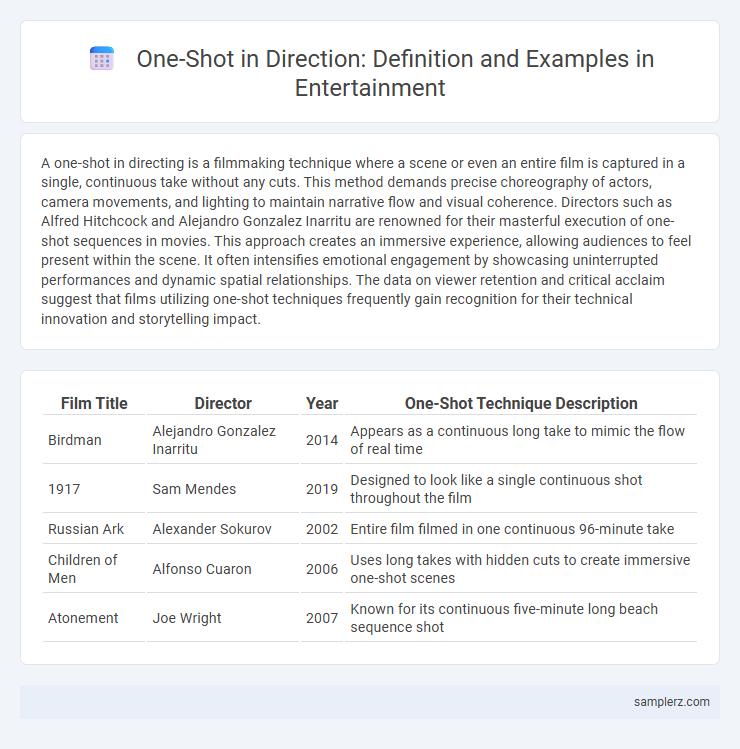A one-shot in directing is a filmmaking technique where a scene or even an entire film is captured in a single, continuous take without any cuts. This method demands precise choreography of actors, camera movements, and lighting to maintain narrative flow and visual coherence. Directors such as Alfred Hitchcock and Alejandro Gonzalez Inarritu are renowned for their masterful execution of one-shot sequences in movies. This approach creates an immersive experience, allowing audiences to feel present within the scene. It often intensifies emotional engagement by showcasing uninterrupted performances and dynamic spatial relationships. The data on viewer retention and critical acclaim suggest that films utilizing one-shot techniques frequently gain recognition for their technical innovation and storytelling impact.
Table of Comparison
| Film Title | Director | Year | One-Shot Technique Description |
|---|---|---|---|
| Birdman | Alejandro Gonzalez Inarritu | 2014 | Appears as a continuous long take to mimic the flow of real time |
| 1917 | Sam Mendes | 2019 | Designed to look like a single continuous shot throughout the film |
| Russian Ark | Alexander Sokurov | 2002 | Entire film filmed in one continuous 96-minute take |
| Children of Men | Alfonso Cuaron | 2006 | Uses long takes with hidden cuts to create immersive one-shot scenes |
| Atonement | Joe Wright | 2007 | Known for its continuous five-minute long beach sequence shot |
Defining the One-Shot Technique in Film Direction
The one-shot technique in film direction involves capturing an entire scene or sequence in a single continuous take without cuts, enhancing immersion and narrative flow. This method demands precise choreography, meticulous planning, and seamless coordination among actors, camera operators, and crew. Notable examples include the opening sequence of "Touch of Evil" by Orson Welles and the relentless tracking shots in "Birdman" by Alejandro G. Inarritu, showcasing the power of uninterrupted storytelling.
Iconic One-Shot Scenes in Movie History
The iconic one-shot scene in "1917," directed by Sam Mendes, masterfully immerses viewers in a continuous, unbroken take that heightens tension and realism on the battlefield. Alfred Hitchcock's "Rope" employs a seamless long take to create an intense, claustrophobic atmosphere, emphasizing the unfolding psychological drama. This technique enhances storytelling by maintaining spatial and temporal continuity, allowing audiences to engage deeply with the narrative flow.
The Artistic Impact of Uninterrupted Takes
One-shot direction enhances cinematic storytelling by immersing viewers in continuous, uninterrupted action that deepens emotional engagement and heightens tension. This technique showcases a director's precision and creativity, demanding meticulous choreography, lighting, and camera movement to maintain seamless flow. Notably, films like "1917" and "Birdman" exemplify the artistic impact of one-shot takes, transforming narrative pacing and visual experience.
One-Shot Examples in Television Episodes
One-shot television episodes, such as "True Detective" Season 1 Episode 4, showcase masterful direction with extended continuous shots that enhance narrative immersion and tension. These episodes utilize a single, fluid take to create realism and maintain viewer focus on character interactions and environmental details. By eliminating traditional cuts, one-shot sequences deliver a compelling, uninterrupted visual experience that elevates storytelling in television.
Technological Innovations Enabling Long Takes
Technological innovations such as the Steadicam and drone cameras have revolutionized long takes, enabling directors to create seamless, uninterrupted shots that enhance narrative immersion. Advances in digital stabilization and lightweight camera rigs allow for complex choreography and dynamic movement within a single continuous shot. These tools empower filmmakers to explore new storytelling techniques, pushing the boundaries of visual creativity in entertainment.
Notable Directors Famous for One-Shot Sequences
Alfred Hitchcock's "Rope" is a pioneering example of one-shot direction, creating tension through uninterrupted, continuous takes that mimic real-time events. Alejandro Gonzalez Inarritu's "Birdman" showcases seamless one-shot sequences, enhancing the film's immersive experience and fluid narrative flow. Sam Mendes' "1917" employs a masterful one-shot approach to portray the relentless intensity of World War I, immersing viewers in a single continuous battlefield journey.
The Challenges and Risks of Filming in One Take
Filming a one-shot requires precise choreography and seamless coordination between actors, camera operators, and lighting crews to maintain continuous focus and narrative flow. The risks include potential technical failures, timing errors, and limited opportunities for correction, which can result in costly reshoots and increased production time. Despite these challenges, one-take sequences enhance immersion by delivering uninterrupted storytelling and authentic performances.
How One-Shots Enhance Audience Immersion
One-shots in direction intensify audience immersion by creating continuous, uninterrupted scenes that maintain tension and realism, as seen in films like "1917" where the seamless camera movement mirrors the protagonist's journey. This technique eliminates temporal and spatial cuts, allowing viewers to experience events in real-time, fostering a deeper emotional connection and heightened suspense. The uninterrupted focus also amplifies the actors' performances, making the narrative more compelling and engaging for the audience.
Planning and Choreography of Complex One-Shots
The planning and choreography of complex one-shots in film direction rely heavily on meticulous storyboard creation and precise actor blocking to ensure seamless movement within a single continuous take. Techniques such as pre-visualization and rehearsal sequences are essential to synchronize camera motion with actors' performances, capturing dynamic scenes without cuts. Notable examples like the continuous long take in "1917" showcase how intricate coordination between camera operators, performers, and set designers transforms challenging sequences into immersive storytelling experiences.
Comparison: One-Shot Scenes vs. Traditional Editing
One-shot scenes create a continuous, immersive experience by capturing an entire sequence in a single take, contrasting with traditional editing that relies on multiple cuts for pacing and perspective shifts. Films like "Birdman" exemplify the seamless, real-time intensity achievable with one-shot direction, enhancing viewer engagement through uninterrupted visual storytelling. Traditional editing allows for precise control over timing and emotional emphasis, making it ideal for complex narratives requiring varied focal points.

example of one-shot in direction Infographic
 samplerz.com
samplerz.com